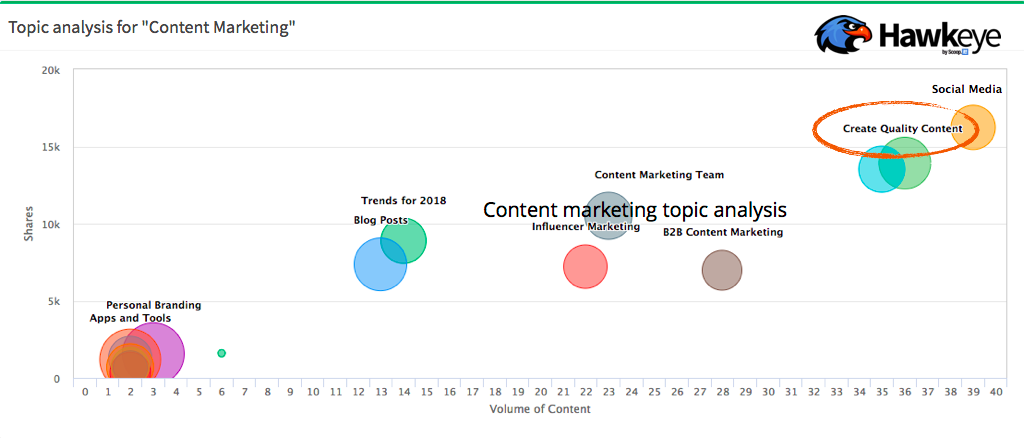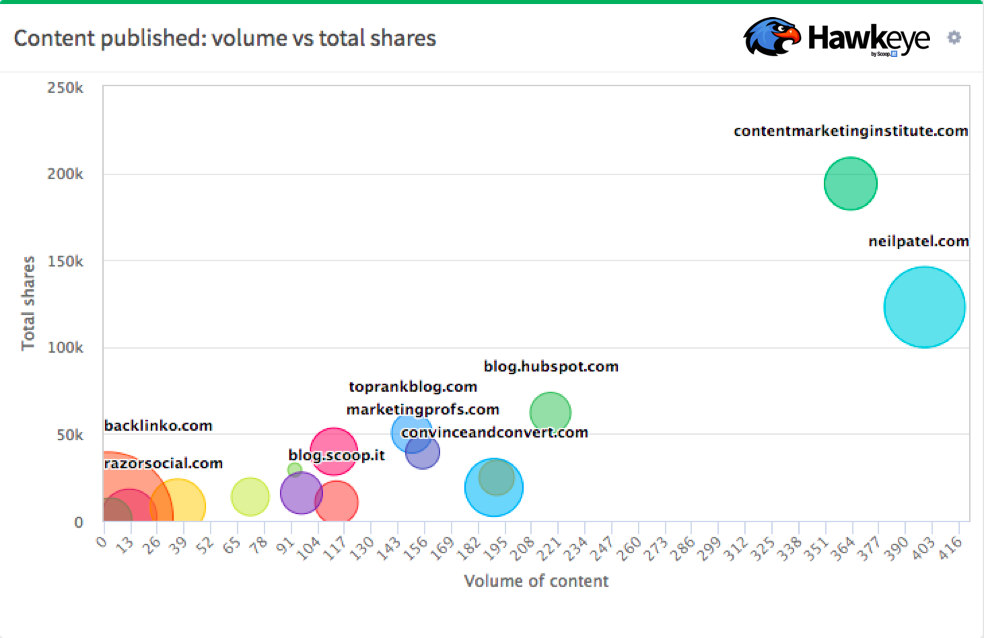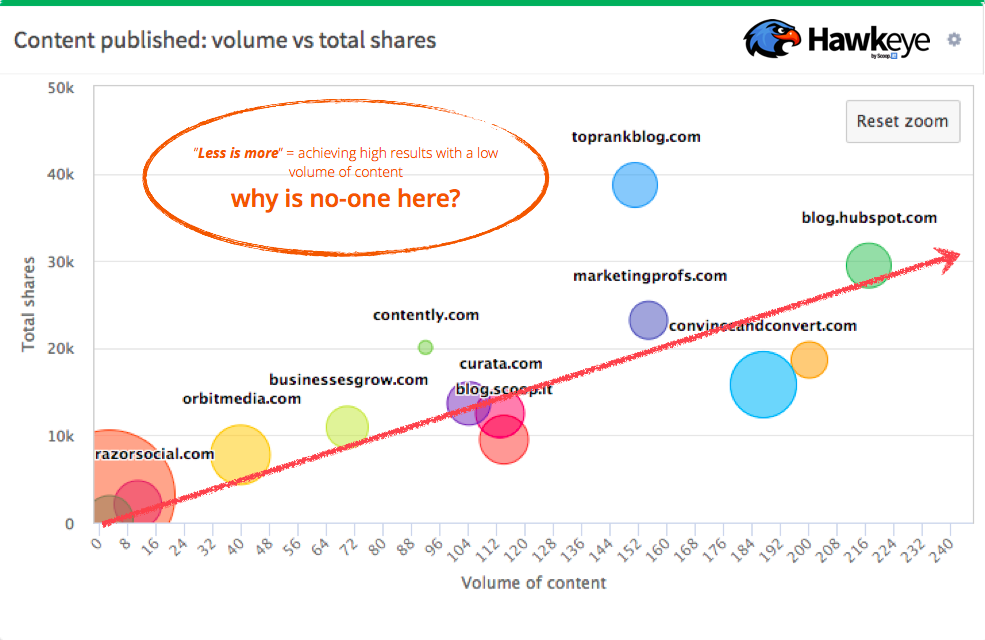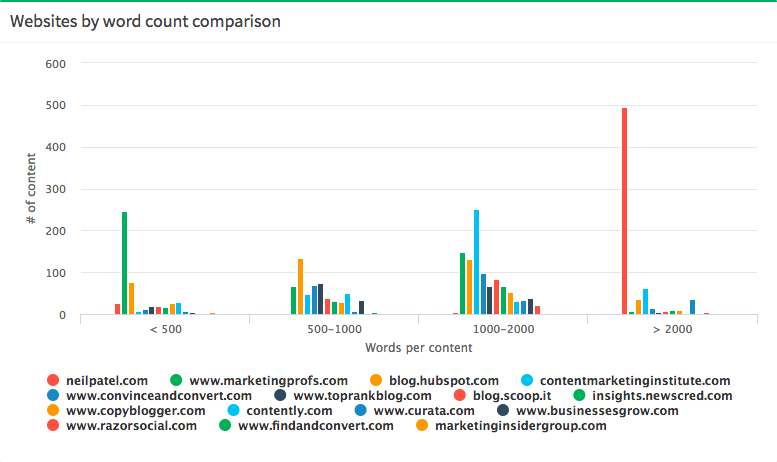
If you read content marketing blogs, many of them will recommend to focus on quality and not on quantity. The mantra is: less is more.
Focus on doing a few great pieces of content rather than exhaust yourself or your team producing more and more. Of course, nobody ever recommended that you do low-quality content. But can you really get away with producing a few great blog posts or infographics? Or do you have to build a content marketing machine that cranks out a large volume of content weekly or even daily?
This “more vs better” question has been around for a while. To quote some of the recent contributions, Michael Brenner gathered a number of interesting research data and contributions in this post. And Chad Pollitt looked at the Pros and Cons of focusing on great storytelling in content marketing to conclude:
“I’ve yet to find a truly compelling argument as to exactly why brands should focus most of their content marketing attention on storytelling. It has its place, but is certainly no marketing panacea. Stick with solving problems thoroughly, but quickly, using content and you can’t go wrong.”
Chad Pollitt – founder, Relevance
With the launch of Hawkeye, our new content intelligence platform, we had the opportunity to contribute new data to this debate: we analyzed what 16 of the top content marketing blogs produced over the past year related to content marketing.
And we looked for an answer to this question:
Which of the top content marketing blogs are successfully applying a “less is more” content strategy consisting in producing a low volume of outstanding content that delivers exceptional results?
The blogs we analyzed are:
neilpatel.com
marketingprofs.com
blog.hubspot.com
contentmarketinginstitute.com
convinceandconvert.com
toprankblog.com
blog.scoop.it
insights.newscred.com
copyblogger.com
contently.com
curata.com
businessesgrow.com
razorsocial.com
findandconvert.com
marketinginsidergroup.com
Here’s what we found out.
Content quality is one of the most written about topics in content marketing
Is content quality really a hot topic in content marketing?
Apparently, it is.
One of the things Hawkeye enables us to do is to understand what topics one or several websites are publishing about.
Analyzing the above websites for the past year, Hawkeye found that “Create quality content” is one of the most written about topics these top content marketing blogs covered. It’s also one of the most popular topics as we can see in the graph below where the X-axis shows the volume of content on a given topic and the Y-axis the popularity of the content on that topic (defined by the total number of shares on social networks).
Click on the image to enlarge
We can see “Create quality content” is in the top right which means that a lot of content was written on that topic and that this content was shared a lot across social networks. Overall, it outperformed content on influencer marketing or on how to develop a content marketing team even though they’re also very popular.
“We always emphasize to our customers that it’s better to focus on higher quality content and don’t just create for the sake of it. When you invest time in high-quality content you should invest more time in content promotion. This will dramatically improve the shares.”
Ian Cleary – Founder, Razor Social
Quality vs quantity: what do top content marketing blogs focus on?
Hawkeye uses the Scoop.it engine to crawl the web so it’s easy to answer the quantity question: for each of these sites, we’ve measured the volume of content published over the past year.
Measuring quality is more subjective. But the main reason marketers should focus on quality is not to win a literary prize. It’s to get results. And results are something we can measure by counting the number of times each piece of content has been shared across social networks (in short popularity). True it’s only one way to measure success but we’ll use it as a good enough proxy for quality. It might not do justice to some specific, high-quality piece of content that didn’t become popular but on average and – perhaps more importantly – for marketers pressured to deliver results, this is a metric that matters.
The first way we can look at these top blogs is by plotting each of them with:
- the volume of content on the X axis
- the total shares or popularity obtained by their content on the Y axis
And we get the following graph:
Click on the image to enlarge
On the above graph, the more a blog is to the right, the more it published content. The more it is to the top, the more its content is shared. (Note: the size of the bubbles is the average word count for each piece of content – but more on that later).
The first observation from this graph that is striking to me is how much alignment there is. There’s a nice trendline that shows that total shares and volume are tightly correlated. This means that these 15 blogs are pretty much getting the same average popularity per piece of content. Of course, that’s on average and there are variations but the alignment is pretty clear: for the stat lovers among you, the r2 is .90 (and even .96 if we remove contentmarketinginstitute.com).
“Outside of CMI and Neil Patel, we’re getting substantially more social shares than the other marketing blogs mentioned and with only 3 blog posts per week. 3X a week vs. 5X is a Q1 test and we are definitely focused on quality. But what makes our content effective is consistency with that quality vs. quantity alone. Another consideration is distribution and amplification. A network of interested subscribers and followers is nearly as valuable as the quality of your content.”
Lee Odden – CEO and co-founder, TopRank Marketing
In other words, statistically speaking, the only way these 15 blogs differ is by publishing more or less content. Don’t take me wrong: these blogs are very different for many reasons. But the overall total popularity they generate is directly correlated to the amount of content they publish: the more content they publish, the more popular they are.
Which leads to a second observation:
Click on the image to enlarge
Nobody’s in the upper left corner.
This means no one managed to be a leader in popularity with less content than their peers. There are no examples among these 15 blogs of a successful strategy from a super focused blog that would have produced – say – less than 10 blog posts but with extreme focus on quality to overcome scarcity.
In other words, none of these top 15 blogs seems to be successfully applying a “less is more” strategy.
“What’s great about this data is that it shows that publishing more content correlates with results. And it proves that many of the proponents of the “Less is More” approach are actually doing the opposite of what they preach and focusing on “More is More” as a strategy.
So if someone tells you to “stop creating more content,” call out their BS because the data shows that producing more quality content simply works better than any “less” content approaches.
Quality vs Quantity is a false choice. Real “publishers” have known this from the dawn of modern media. And brands that invest in content marketing and measure their results are following their lead of consistently creating more quality content. The key to marketing success in today’s world is (what I call the “3 Vs” approach) to create the highest possible Volume and Variety of Valuable content.”
Michael Brenner – CEO, Marketing Insider Group
Quality is not enough (for top content marketing sites)
Of course, you could argue that these blogs have very different resources available for both production and distribution.
But first, the strong correlation between quantity and popularity suggests that more resources doesn’t mean better average quality. Ian Cleary’s razorsocial.com – a small and lean content operation – generates about the same amount of shares per post as Curata, a startup employing a professional content team, or HubSpot, a public company with a massive content operation. So while scaling resources definitely is a way to generate more results, it doesn’t seem to be a way to improve average quantity and returns.
Second, if you zoom in on the pack in the lower left, excluding the 2 clear leaders which are CMI and Neil Patel, you find the correlation remains pretty solid:
Click on the image to enlarge
And you still don’t have anyone in the ideal “less is more” top left corner. So again, none of these blogs are able to rely on a few hits to outperform their peers. They have to rely on volume too.
“While many marketers will agree that quality is king, we all know that volume matters. I’m often asked: How many blog posts should I publish a week? and the answer is: it depends…
Here’s the thing: the internet is a noisy space and there’s more brands competing for shares, views and visits than ever before across many different channels. This level of noise is pushing brands to create more content which ultimately opens up new opportunities for organic and referral traffic. We can all agree that quality matters but we have to also accept the fact that more content = more opportunities.”
Ross Simmonds – Founder, Hustle & Grind / Crate
But neither is quantity
“Our content focus isn’t driven by quality over quantity or less is more. Rather our content strategy is focused on meeting the needs of our buyer throughout their buying journey on a topic by topic basis.”
Bernie Borges – CMO, Vengreso
The flip side of that coin is that neither of these blogs seem to be focusing the exact opposite strategy which would be sacrificing quality to publish more. While the above numbers definitely show that – at least in the content marketing category – more is more, there doesn’t seem to be a way to win by publishing a lot of poor quality content.
“For SEO alone, we know now that Google does not reward publishing lots and lots of content on the same topic. In fact, Google doesn’t want you to publish content just for the sake of publishing content. Google’s Gary Illyes has said this. Fewer pages of higher quality will net more SEO rankings. Brian Dean is one of the best experts to clarify what happens when you create too much content on the same topic: he calls these “zombie pages” and recommends unpublishing them. So from an SEO standpoint, one piece on one topic + super, 10x high quality = always wins. For Q1 2018, I’ve focused on this mantra in my blog at Express Writers, and we’re already seeing far better results (so far, a 100% increase in rankings AND high-quality backlinks). It’s all about high-quality content. If you focus on creating the world’s most comprehensive, 4,000-word piece on a topic your readers are interested in, and that takes you a month: that could be far more worth it for higher-quality inbound traction than pushing out a blog weekly that doesn’t hold half as much research weight.”
Julia Mc Coy – founder & CEO, ExpressWriters
Another way to look at this is by looking at the average length of content these blogs publish. Of course, length doesn’t equal quality but it’s another proxy that we can access to and that can help understand the picture.
Click on the image to enlarge
Most of these blogs are pretty homogeneous on this too. The sweet spot for content marketing articles from these blogs is in the 1000-2000 word range and the distribution among them is fairly consistent. There are a few notable exceptions:
- MarketingProfs has a lot of short content but these are mostly infographics embedded in blog posts. These are great pieces of content and that’s a limit of analyzing quality by word count.
- Neil Patel mostly has 2,000+ word pieces. And he’s actually famous for that.
“It’s hard to consistently publish high-quality content. So when you are able to do so, it definitely helps you stand out from the competition. Publishers like the Content Marketing Institute have built a reputation for being a consistently high-quality, non-promotional resource for great content. And they earned that trust by turning up each day with content that doesn’t deviate from their mission. Could they have achieved that if they published twice per week? Maybe. Once per month? I don’t think so.”
Erika Heald – Content Marketing Consultant, Erika Heald
Quantity vs quality in content marketing: key takeaways
This benchmark has some limitations. It focuses on blog content only and – for some of these sites – on specific subdomains. This means it might exclude some other content areas that could have impacted results. For instance, at Scoop.it, we produce a blog and a resource center. Our resources are typically our highest quality content that we carefully curate from all of the content we produce and regularly update based on performance history. They’re not in that benchmark.
But I still believe we can draw some conclusion out of this data. For these top content marketing blogs, success isn’t achieved by focusing on quality or quantity at the detriment of the other. They build their audience through a combination of highly successful posts and a long tail of much less successful ones.
The data confirms what we’ve been seeing for years with client blogs.
“Publishing one or two posts per week simply isn’t enough to move the needle on audience growth and lead generation, especially if you’re starting from a limited traffic and subscriber base. High-quality content is essential, but frequency and variation of format are critical to consider when building a content strategy.”
Paul Roetzer – founder, Marketing AI institute
Just like record labels had to invest in many artists to have a few rolling stones or VC’s in many startups to have a Facebook, the most influential content marketers seem to hedge their bets and, while they never compromise their brand with poor quality content, they play a volume game too.








Great, data-backed piece!! Honored to be included in this.
A great article that nicely reflects the importance of quality but still we can see that most play the high frequency of posting. However, it may be a good idea to look at Brian Deans Backlinko blog that has a low frequency of posting but still gets a big amount of traffic.
Its true. I also believe there should be a quality content. Otherwise, I, myself, doesnt like to read poor quality and less informative contents over internet. But, at the same time, I also believe that if quality comes with quantity then it would be absolutely incredible.
Great Insights mate 🙂
Loved the post. Really Useful
Nice Article! Thanks for sharing such a beautiful informative information on the Blog. I really appreciate the blog it’s very useful. I look forward to get more articles on Content marketing. Nice post!